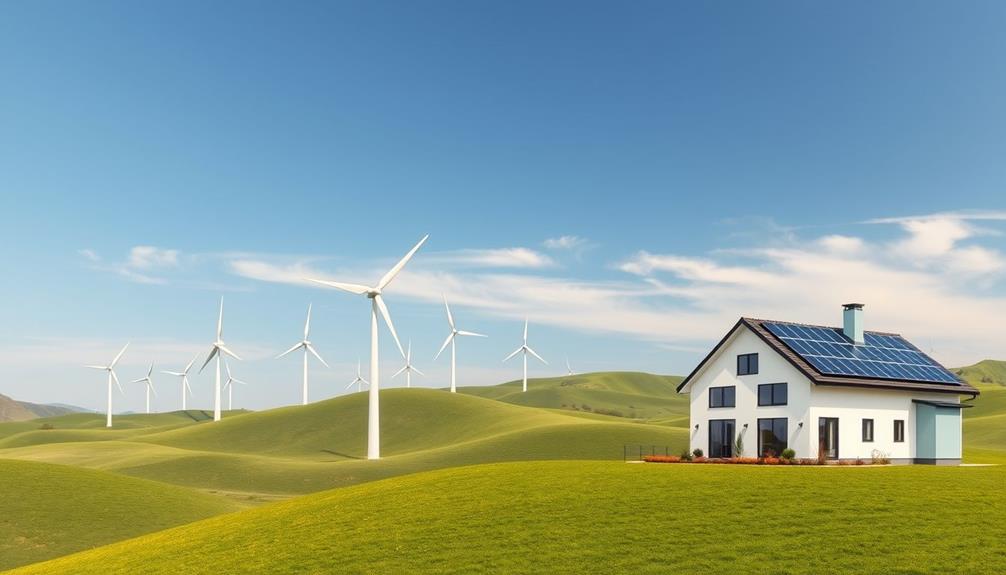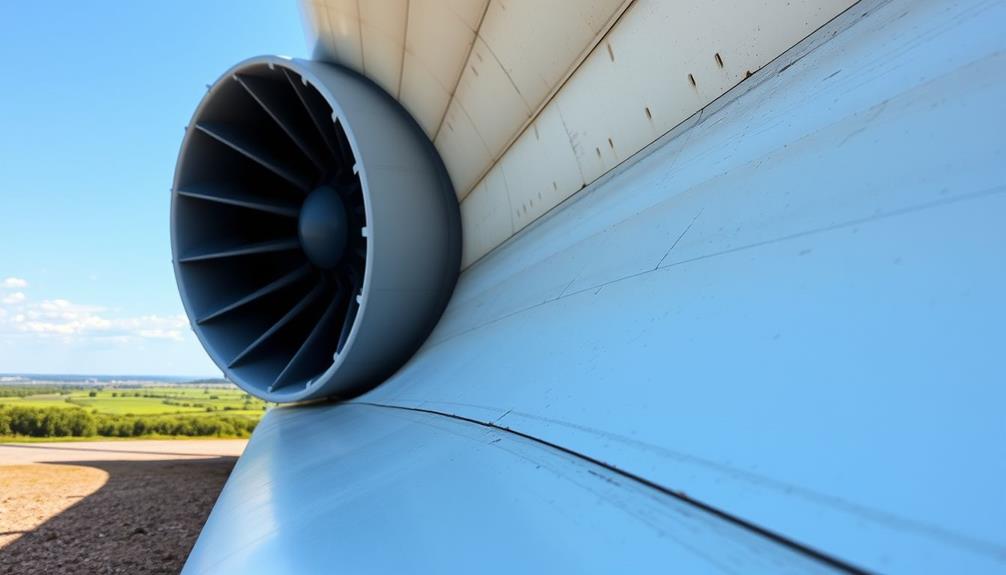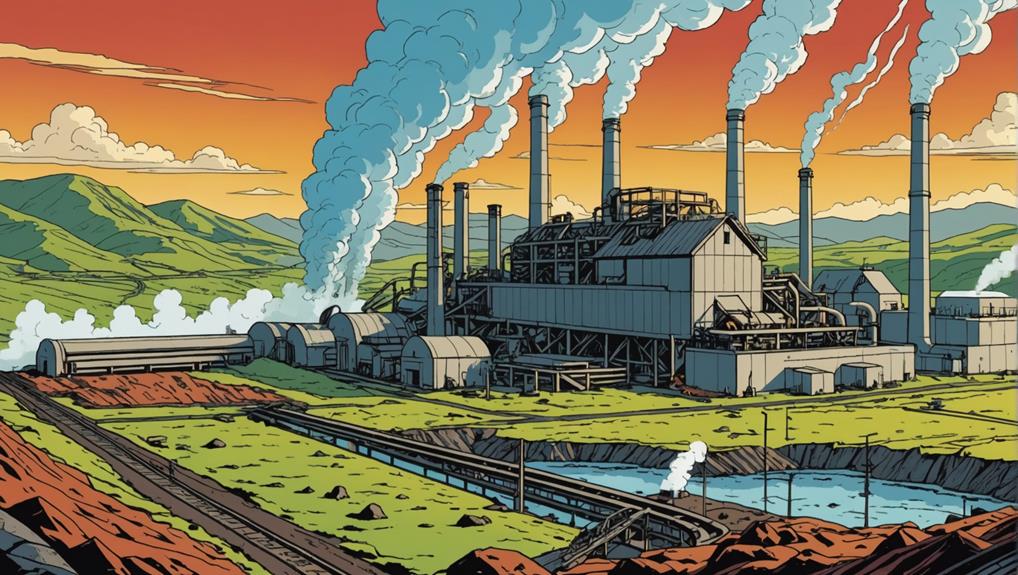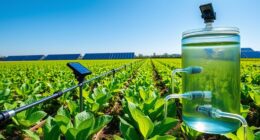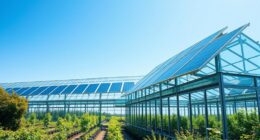Installing wind power generators can cut your electricity bill in half. By harnessing wind energy, you can greatly reduce costs, especially if you live in a suitable location with consistent wind patterns. Advances in turbine technology have lowered installation expenses and improved energy capture. You can also take advantage of tax credits and rebates to offset initial costs. With proper siting and maintenance, your wind system can remain efficient and cost-effective for years. Curious about the specific steps to maximize savings and guarantee peak performance? There's plenty more to explore on how to make wind power work for you. To ensure you are getting the most affordable wind generators, it’s essential to do your research and compare different options available on the market. Look for reliable and reputable manufacturers that offer warranties and good customer support. Additionally, consider consulting with a professional to determine the best location and size for your wind power system. By investing in affordable wind generators and taking advantage of available incentives, you can significantly reduce your electricity expenses while contributing to a more sustainable and environmentally friendly energy source.
Key Takeaways
- Wind power can reduce electricity bills by up to 50% through lower energy costs and efficient energy generation.
- Installing wind turbines in high-wind areas maximizes energy production and reduces overall electricity expenses.
- Federal and state incentives, like tax credits and rebates, can significantly lower installation costs for wind power systems.
- Regular maintenance and innovative turbine designs enhance efficiency, leading to increased energy output and savings.
- Combining wind power with other renewable sources, like solar, improves energy reliability and long-term savings.
Benefits of Wind Power
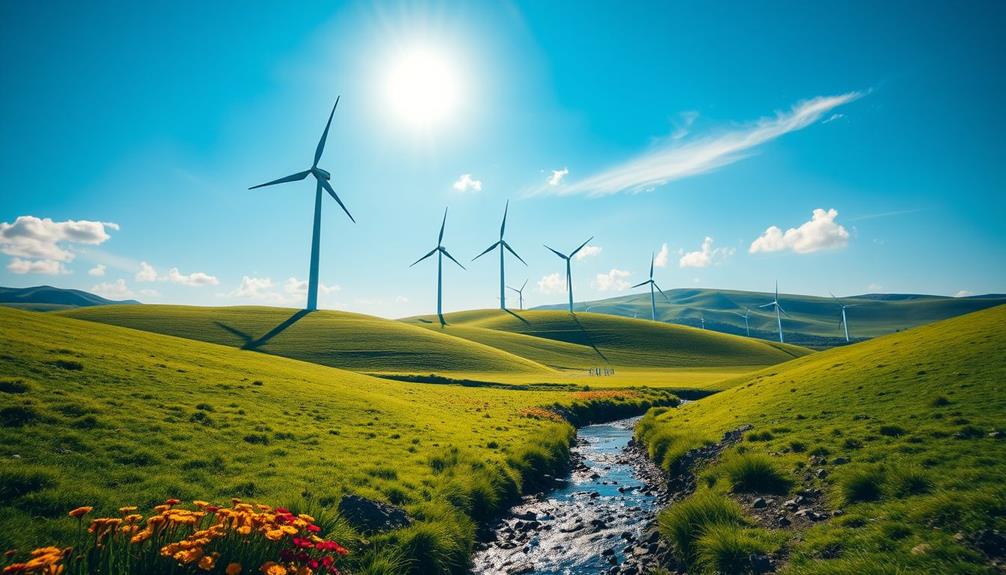
Wind power offers numerous benefits that can greatly impact your energy costs and environmental footprint. By harnessing the wind, you can considerably reduce your electricity bills—potentially by up to 50%.
With the increase in installed capacity of wind power, the levelized cost of energy (LCOE) has become competitive with traditional fossil fuels. This means that investing in wind energy not only makes economic sense but also enhances your energy independence.
In addition, as the weight of wind turbine blades varies, advancements in design and materials contribute to more efficient energy capture and reduced installation costs. If you live in areas known as the "wind belt," you'll find that wind power systems provide reliable and cost-effective electricity.
As technology advances, innovations in wind energy could halve costs by 2030, making it an even more attractive option for homeowners. Moreover, with projections indicating that unsubsidized wind energy prices could drop below natural gas costs, now's the time to reflect on switching to wind power.
Understanding Wind Energy Costs
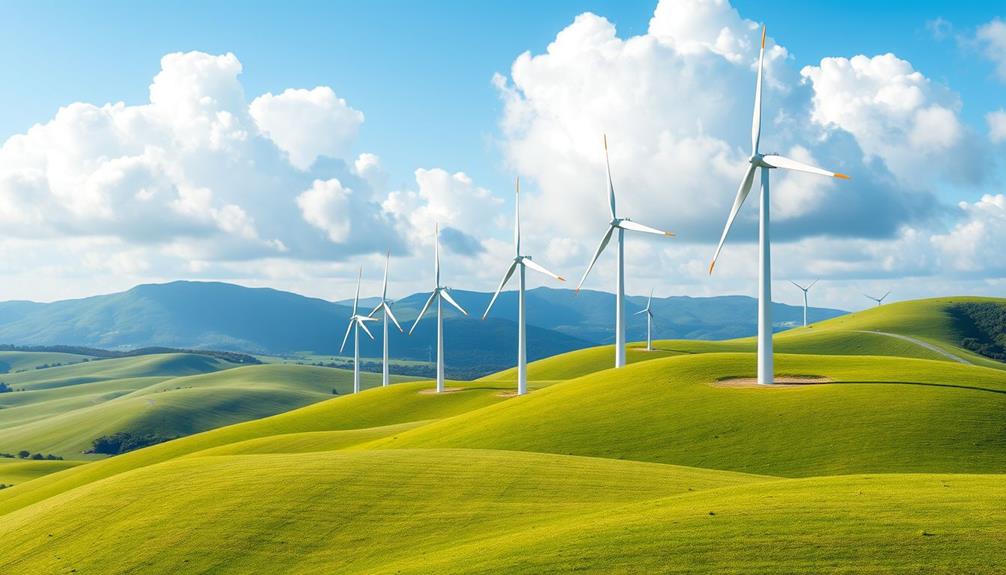
When you consider wind energy costs, you'll notice significant reductions in expenses over recent years.
The growing demand for transparency in private equity investments has led to increased interest in renewable energy projects, including wind power.
With projections showing that costs could fall even further by 2030, it's becoming clear that wind energy is a competitive alternative to traditional fuels.
Understanding these trends can help you make informed decisions about energy options for the future.
Reducing Wind Energy Expenses
Reducing Wind Energy Expenses (Understanding Wind Energy Costs)
As the demand for renewable energy grows, understanding the costs associated with wind energy becomes essential for consumers and investors alike. Wind energy has become increasingly competitive, with installed project costs for new wind farms dropping by 33% from 2009 to 2016. This makes it a viable alternative to traditional sources like natural gas.
By 2016, wind energy had become the third-most installed energy capacity in the U.S., reflecting a growing reliance on this renewable source. Additionally, much like Gold IRAs offer tax advantages, wind energy benefits from various incentives that can enhance its cost-effectiveness.
Thanks to tax credits, newly built wind plants are already cost-competitive with natural gas plants, especially in the U.S. wind belt, which stretches from Texas to North Dakota. Moreover, advancements in technology—backed by research initiatives like the Department of Energy's Atmosphere to Electrons program—aim to reduce wind energy production costs even further.
In fact, the National Renewable Energy Laboratory (NREL) projects that these innovations could potentially halve wind energy costs by 2030.
Future Cost Predictions
The future of wind energy costs looks promising, with new technologies set to revolutionize the industry. By 2030, future cost predictions indicate that wind energy could become 50% cheaper, making it highly competitive with traditional sources like natural gas. The National Renewable Energy Laboratory (NREL) has noted a 33% drop in installed project costs from 2009 to 2016, showcasing a consistent trend toward lower expenses.
As wind energy generation continues to rise, it has become the third-most installed energy capacity in the U.S. Projections suggest that by 2030, unsubsidized wind energy costs may dip below current natural gas fuel prices, enhancing its appeal for energy efficiency. The Energy Information Administration (EIA) provides valuable insights through its levelized cost of energy metric, reflecting cost trends per megawatt-hour.
Here's a quick visual representation of these trends:
| Year | Installed Cost Drop | Future Cost Predictions |
|---|---|---|
| 2009 | – | – |
| 2016 | 33% | – |
| 2023 | – | Below natural gas costs |
| 2030 | 50% | Competitive with fossil fuels |
Investing in wind energy now could yield significant savings on your electricity bill.
Installation of Wind Turbines
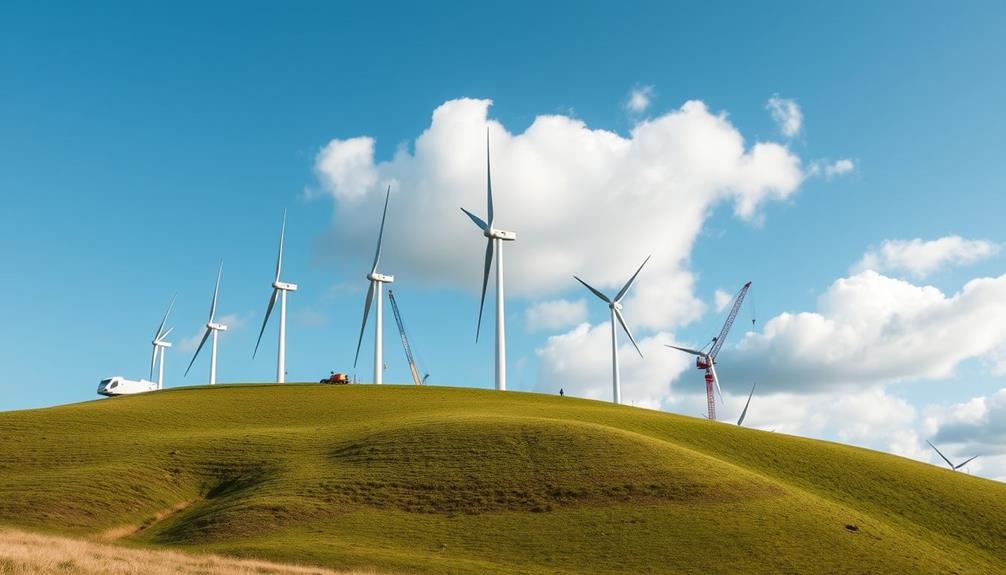
When you're ready to install a wind turbine, choosing the right site is essential for maximizing energy production.
Factors such as local wind conditions and the potential for optimal comfort in varying weather conditions can influence your decision.
You'll also need to take into account the size of the turbine based on your energy needs and local wind conditions.
Understanding the installation process will guarantee everything goes smoothly, allowing you to enjoy the benefits of clean energy sooner.
Site Selection Importance
Choosing the right site for wind turbines is vital to maximizing energy production and efficiency. When you're considering site selection, keep in mind that locations with average wind speeds of 6.5 meters per second or greater can dramatically enhance energy output.
Here's a quick overview of key factors in site selection:
| Factor | Importance |
|---|---|
| Wind Speed | Higher speeds increase energy production. |
| Obstructions | Minimize turbulence by avoiding trees and buildings. |
| Elevation | Higher terrain captures more wind energy. |
| Infrastructure Proximity | Closer to power lines reduces connection costs. |
Conducting thorough wind resource assessments is essential. These assessments can predict energy generation and increase project viability, potentially enhancing power production forecasts by up to 20%. By choosing the right location, you not only improve efficiency but also contribute to sustainable energy solutions. So, when planning your wind turbine installation, consider these factors carefully to guarantee your investment pays off in the long run.
Turbine Sizing Considerations
Selecting the right turbine size is fundamental for maximizing energy production and guaranteeing your investment pays off. When considering turbine sizing, think about your household's energy use and the local wind conditions. Typically, residential wind turbines range from 400 watts to 10 kilowatts. A larger turbine can capture more wind energy, helping you potentially cut your electricity bills considerably.
Additionally, incorporating a design thinking approach can guide you in evaluating user needs and aligning your energy solutions with your lifestyle.
Turbine height and rotor diameter are also essential factors in efficiency. Taller turbines with larger rotors can access higher wind speeds, producing more electricity. It's important to conduct a site assessment to evaluate wind speed and consistency, as a minimum average wind speed of 9 miles per hour is often recommended for effective energy generation.
Don't forget to check local zoning regulations and restrictions, as these can influence the permissible turbine height and placement on your property.
Installation Process Steps
Installing wind turbines involves several critical steps to guarantee peak performance and compliance with regulations.
First, you'll need to conduct a site assessment to determine wind resource availability. Look for locations with average wind speeds of at least 10 miles per hour to optimize energy generation. Additionally, you might consider how recent advancements in AI discovers a cure can influence the efficiency of energy systems and contribute to sustainable practices.
Next, focus on permitting and regulatory compliance, ensuring you adhere to local zoning laws and complete necessary environmental assessments to minimize impacts on wildlife and land use.
Once these initial steps are completed, you can move on to the installation process itself. This includes assembling the turbine components, such as the tower, rotor, and generator, which often requires specialized equipment like cranes to lift heavy parts into place.
After assembly, you must establish proper electrical connections, integrating the wind turbine into your existing power system. This could involve connecting to the grid or setting up an off-grid system with battery storage.
Maximizing Energy Production
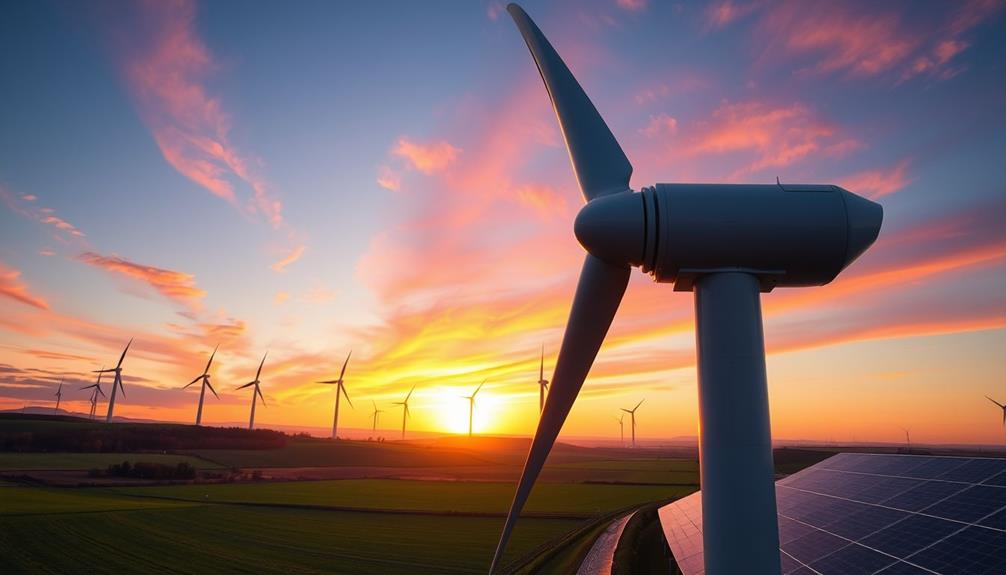
To maximize energy production from wind power generators, it's essential to leverage advanced technologies and innovative designs. By utilizing high-fidelity modeling in your wind plant design, you can considerably enhance energy production estimates. This leads to more efficient operations and higher output, maximizing energy production.
Additionally, consider the advantages of diversifying your energy portfolio; just as with retirement investments, incorporating varied sources can increase overall stability and reliability in energy supply. Implementing tax advantages available when investing in renewable technologies can also improve your financial returns.
Consider investing in innovative turbine designs, such as larger rotors and taller towers. These features have proven to increase energy capture from wind resources. Implementing real-time turbine control systems also plays an essential role. These systems optimize performance and reliability, ensuring you generate the most energy during varying wind conditions.
Moreover, enhanced forecasting techniques for short-term grid operations help better integrate wind energy into the existing grid. This alignment allows your wind production to meet demand more closely, making your energy supply more reliable.
Lastly, keep an eye on continuous research and development initiatives aimed at reducing wind energy costs. As these advancements make wind power increasingly competitive with traditional energy sources, they'll encourage wider adoption of renewable energy solutions.
With these strategies in place, you'll be well on your way to maximizing energy production and cutting your electricity bill considerably.
Maintenance for Efficiency
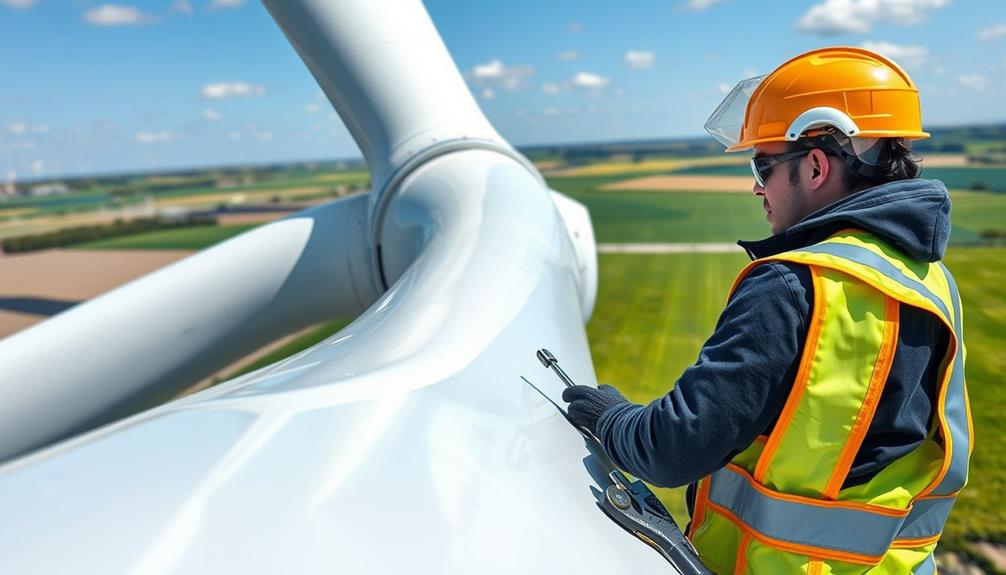
Effective maintenance is vital for maximizing the efficiency of wind power generators. Regular inspections and timely repairs can boost efficiency by up to 10%, helping you cut your electricity bills. Here are some key maintenance practices to keep in mind:
| Maintenance Task | Impact on Efficiency | Frequency |
|---|---|---|
| Inspect and repair components | Reduces downtime | Quarterly |
| Clean turbine blades | Increases output by 20% | Monthly |
| Lubricate moving parts | Extends lifespan of gearboxes | Biannually |
| Align turbines | Enhances energy generation | Annually |
| Use predictive analytics | Anticipates failures | Ongoing |
Keeping turbine blades clean from debris and ice is essential, as dirty blades can greatly reduce energy output. Regular lubrication of moving parts guarantees they function smoothly, extending their lifespan. Additionally, monitoring and adjusting the alignment of turbines makes certain they face the prevailing winds, leading to ideal energy production. By implementing these maintenance strategies, you can enhance the performance and efficiency of your wind power systems, ultimately reducing your energy costs.
Financial Incentives and Rebates
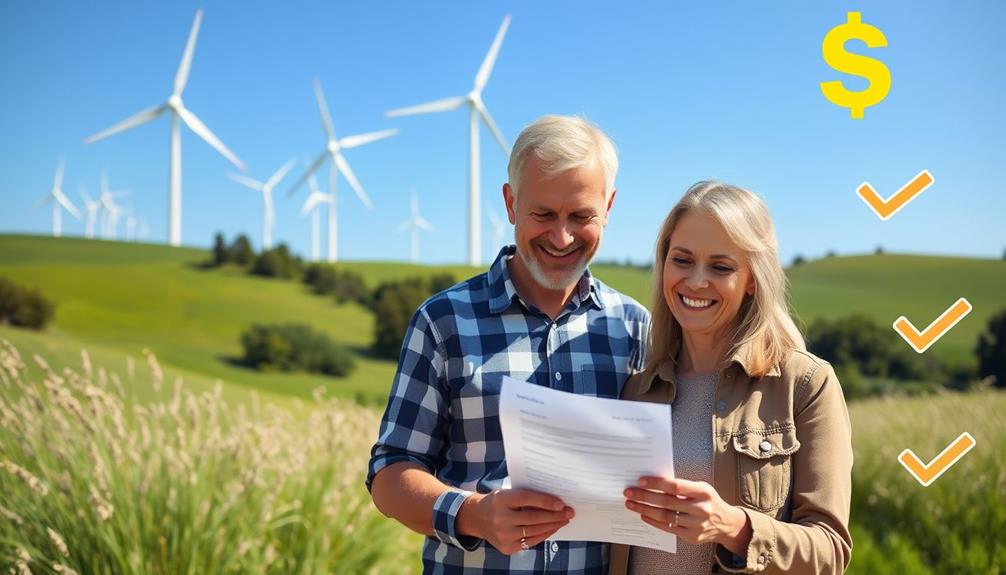
When considering wind power generators, you'll find numerous financial incentives and rebates that can greatly reduce your initial investment. Many states offer tax credits that can cover a substantial portion of your installation costs, making it easier to go green without breaking the bank.
Additionally, the federal government provides a Production Tax Credit (PTC), allowing you to receive 1.5 cents per kilowatt-hour for the first ten years of production. This makes investing in wind power financially advantageous. Furthermore, investing in renewable energy, like wind power, can parallel the benefits seen in precious metal investments, where financial incentives enhance overall returns.
Utility companies often have rebates for homeowners who install wind energy systems, further lowering your installation expenses and enhancing your return on investment. In certain areas, net metering policies allow you to earn credits for any excess energy produced by your wind generator, effectively cutting down your overall electricity bills.
Additionally, programs like the Rural Energy for America Program (REAP) offer grants and low-interest loans, providing extra support for those investing in renewable wind energy systems.
Comparing Wind and Solar

Both wind and solar energy offer compelling benefits for those looking to reduce their electricity bills and embrace renewable resources. When you compare the two, wind power often stands out due to its higher capacity factor. This means wind systems typically produce more electricity over time, especially in areas with consistent wind, giving you more bang for your buck.
Understanding your investment goals regarding renewable energy can help you make informed decisions about which option suits your financial situation best.
Recent advancements have driven down the costs of wind energy, with projections suggesting that prices could drop considerably by 2030, making it competitive with solar in many regions. In places with strong wind resources, wind installations can also provide electricity at a lower upfront cost per megawatt-hour, which can be an essential consideration for your budget.
Moreover, integrating both wind and solar into your energy system can enhance overall reliability. They complement each other well, generating power during different times of the day and year.
Long-Term Savings Strategies

To maximize your energy savings over the long term, consider implementing a combination of smart habits and strategic investments. One effective long-term savings strategy is to invest in ENERGY STAR appliances. These can cut your energy bills by up to 30%, greatly reducing costs for households that spend over $2,200 annually on energy.
Additionally, consider optimizing your cleaning routine with best vacuums for dust removal in 2024, as this can contribute to a healthier home environment and potentially lower energy costs. Also, confirm your home is well-insulated and free of leaks. This can lead to savings of 10-20% on heating and cooling expenses, relieving your HVAC systems from extra work.
Adjusting your thermostat settings by just a few degrees can save you an additional 5-15% on energy bills, especially when using programmable thermostats to automate these changes.
Another simple yet powerful strategy is unplugging unused devices to combat phantom power, which accounts for 5-10% of residential energy use.
Lastly, optimize your laundry practices. By using eco-mode settings and washing full loads, you could achieve energy savings of up to 50% on laundry costs compared to traditional methods.
Frequently Asked Questions
How Much Space Do I Need for a Wind Turbine?
You'll generally need at least an acre of land for a wind turbine. This space allows for proper installation and minimizes turbulence from nearby structures, ensuring your turbine operates efficiently and generates maximum energy.
Can I Install a Wind Turbine Myself?
Installing a wind turbine yourself can feel like building your own ship to sail the skies. If you're handy and follow guidelines, you can do it, but always check local regulations to guarantee compliance.
What Types of Turbines Are Available for Home Use?
You've got several options for home wind turbines. Horizontal-axis turbines are popular for their efficiency, while vertical-axis turbines are easier to install and maintain. Choose based on your energy needs and available space.
How Do I Choose the Right Turbine for My Location?
Choosing the right turbine's like picking the perfect fishing rod; you need to evaluate your local wind speed and landscape. Assess your area's average wind conditions and select a turbine designed for those specific requirements.
Are There Zoning Laws for Installing Wind Turbines?
Yes, there are often zoning laws for installing wind turbines. You'll need to check local regulations, as they can vary by area. Compliance with these laws guarantees your installation is legal and avoids potential fines.
Conclusion
In the dance of renewable energy, wind power can be your partner in cutting those pesky electricity bills in half. By harnessing the breeze, you're not just investing in your home; you're planting seeds for a greener future. With the right setup and some savvy maintenance, you'll watch your savings soar like a kite in the wind. So, embrace the power of the gusts, and let your wallet breathe easy while you contribute to a sustainable world.
